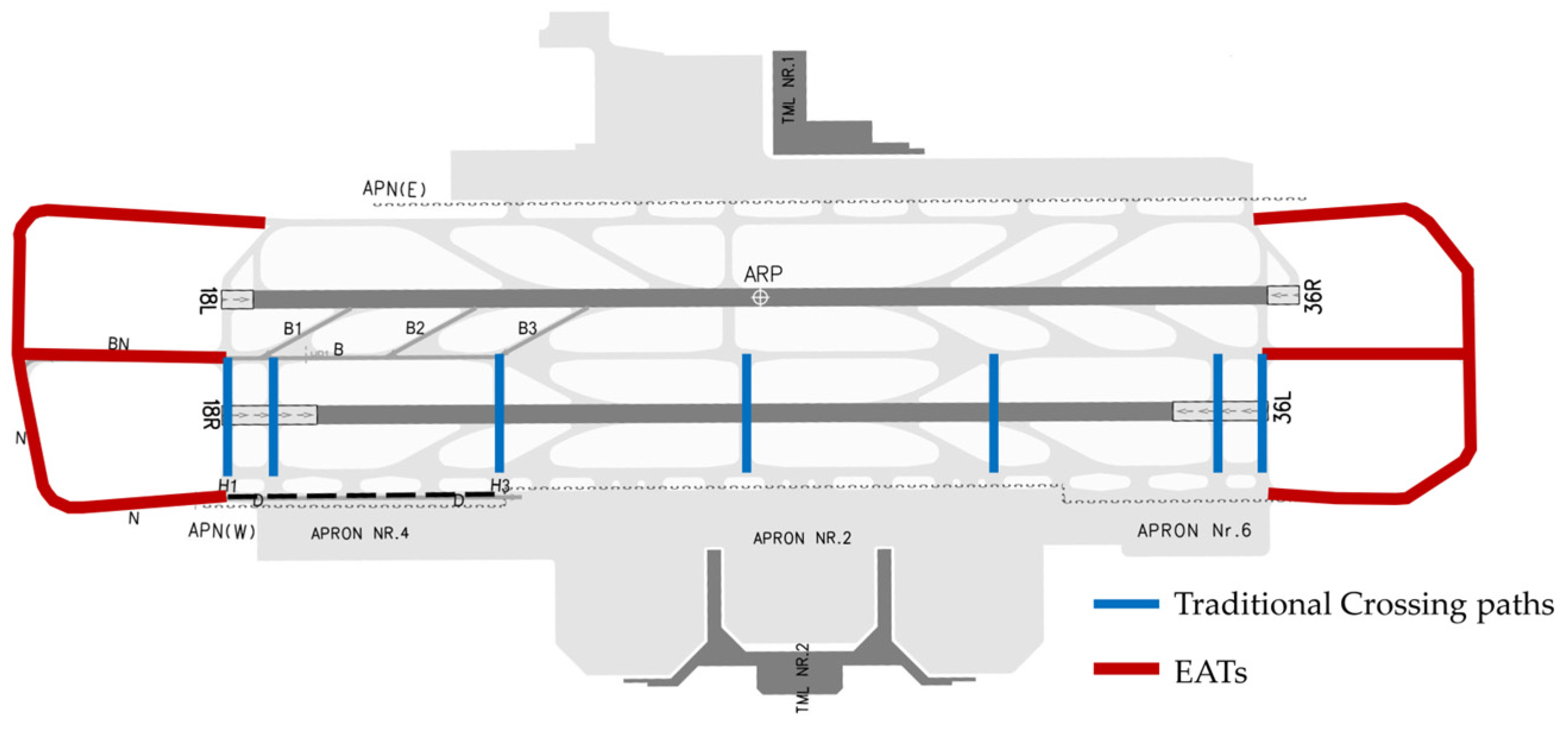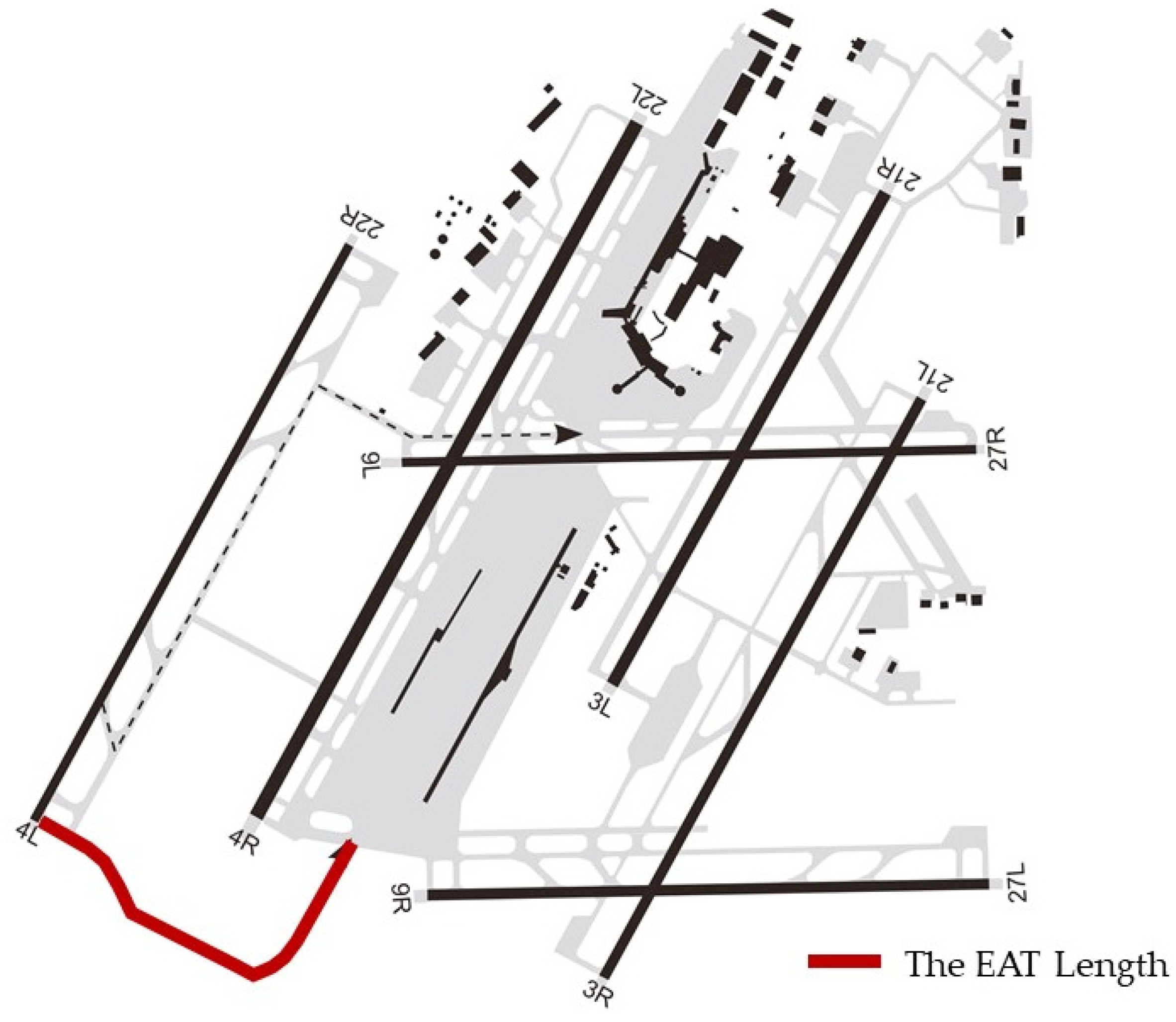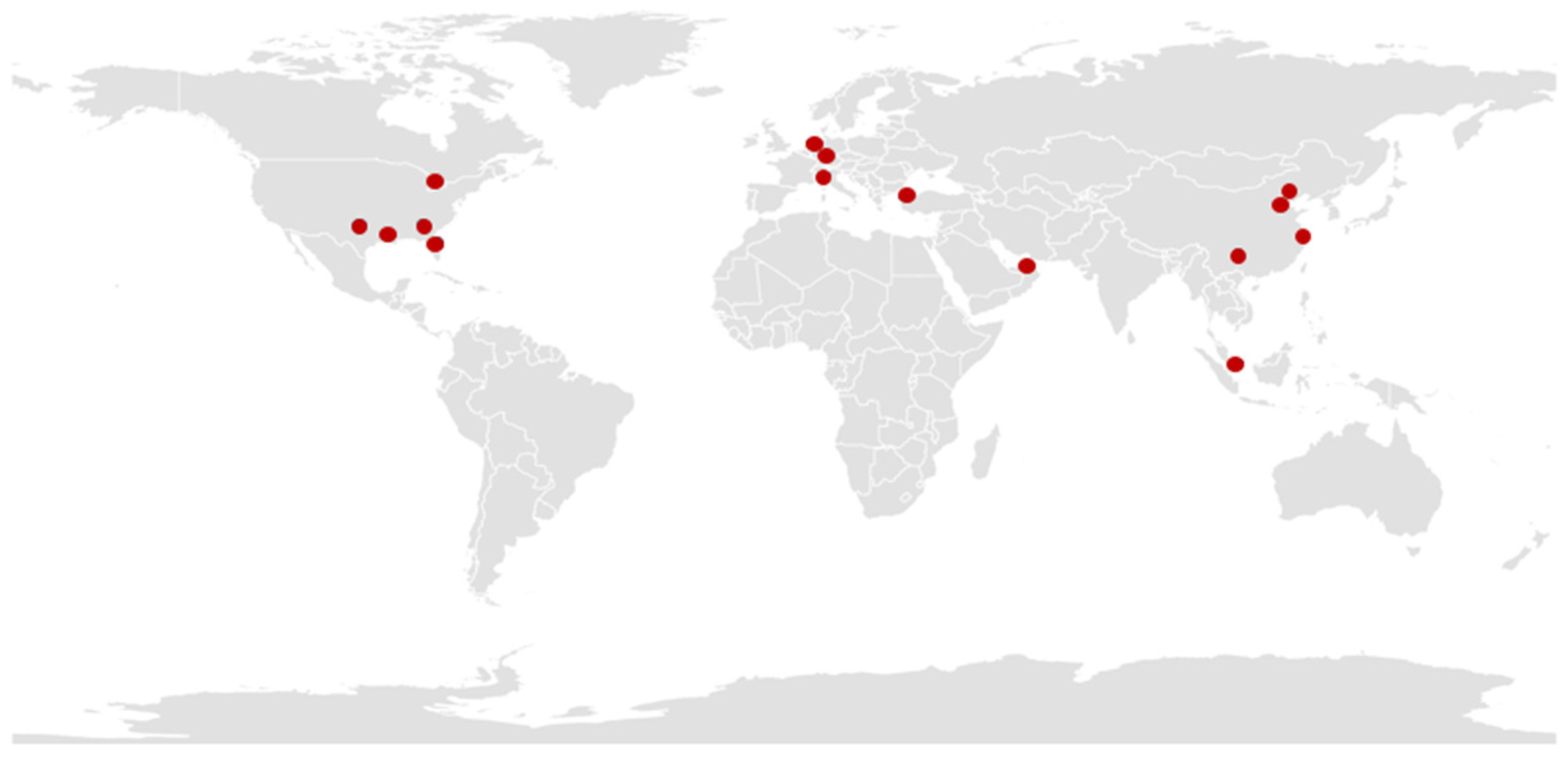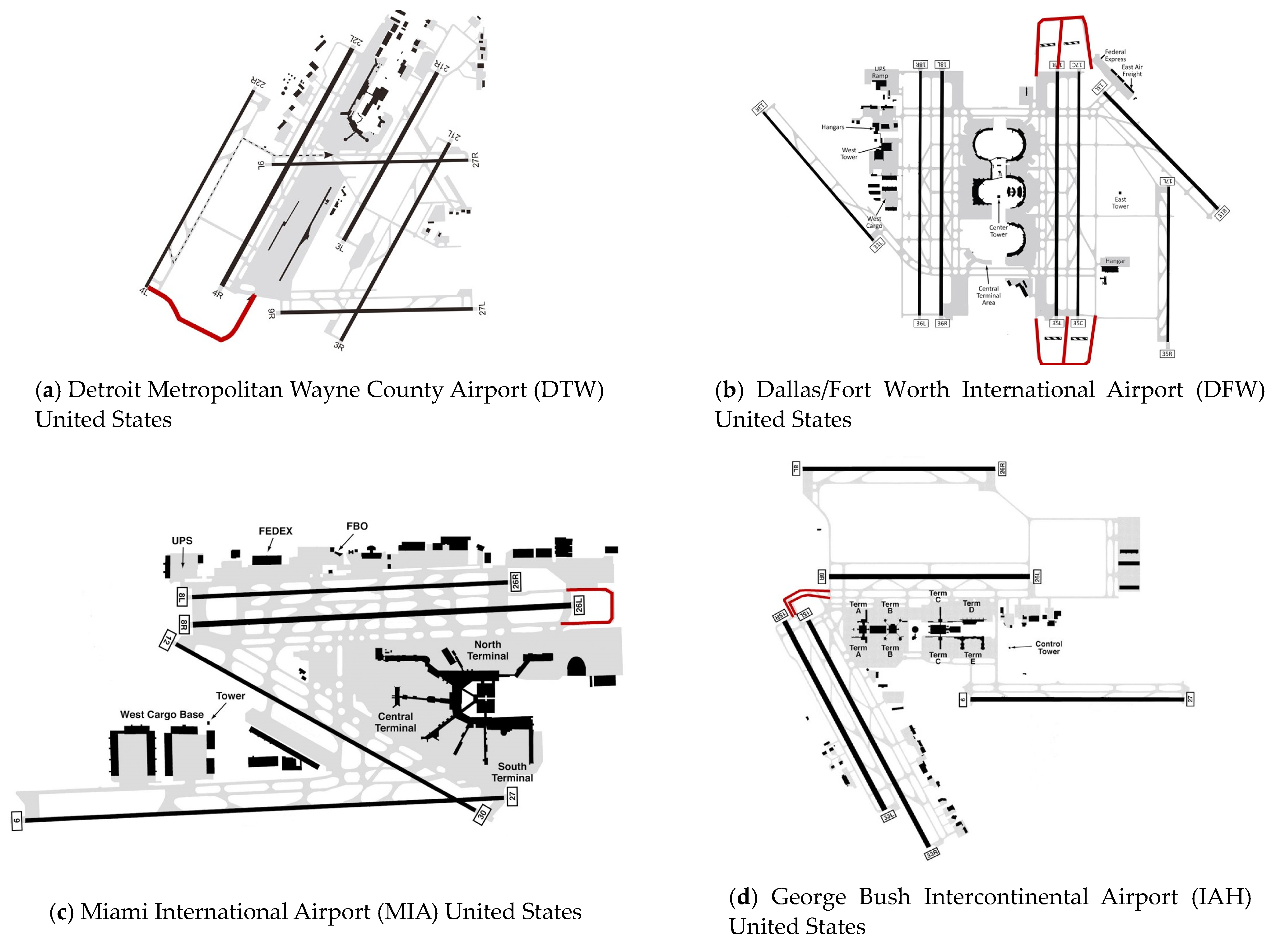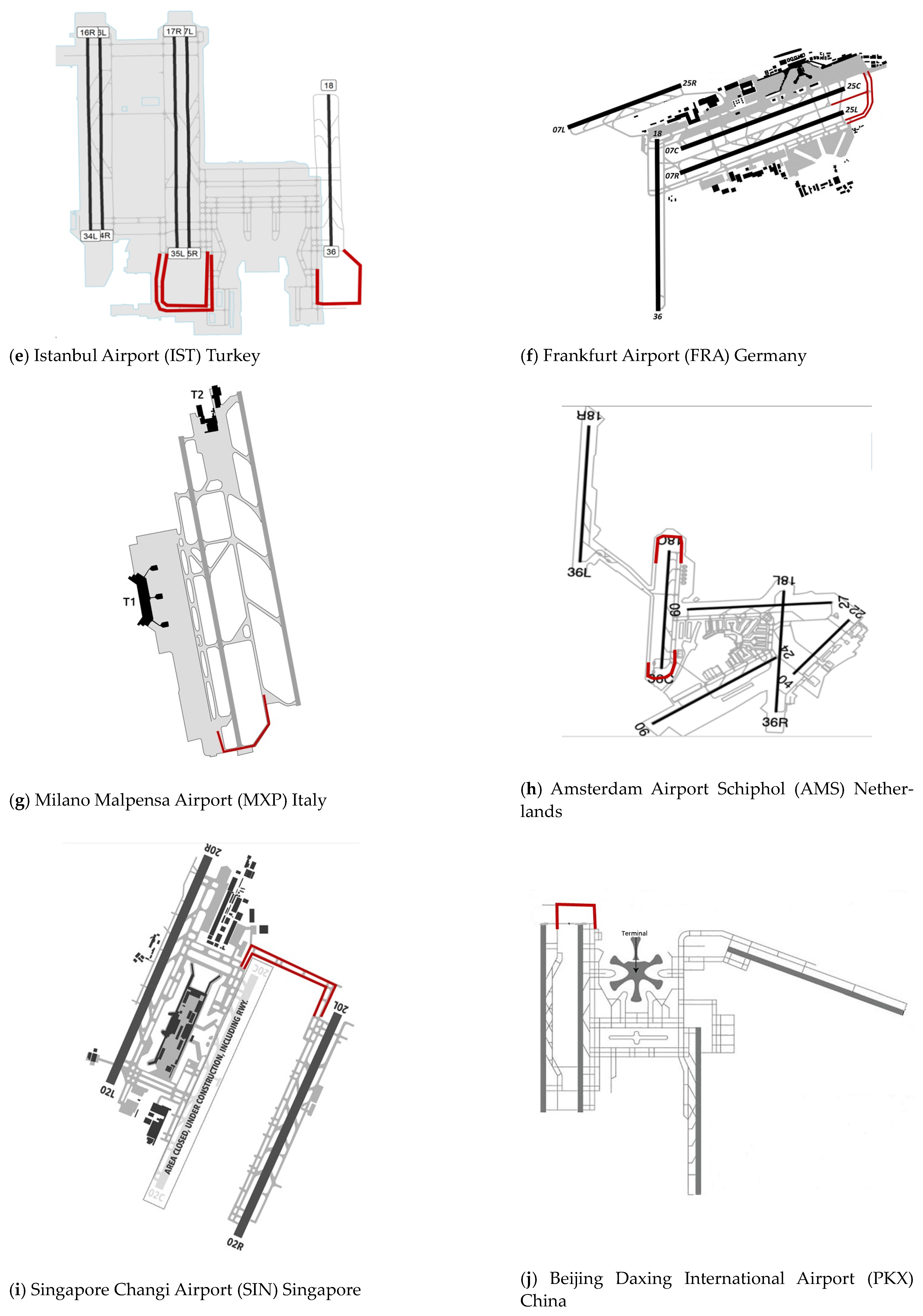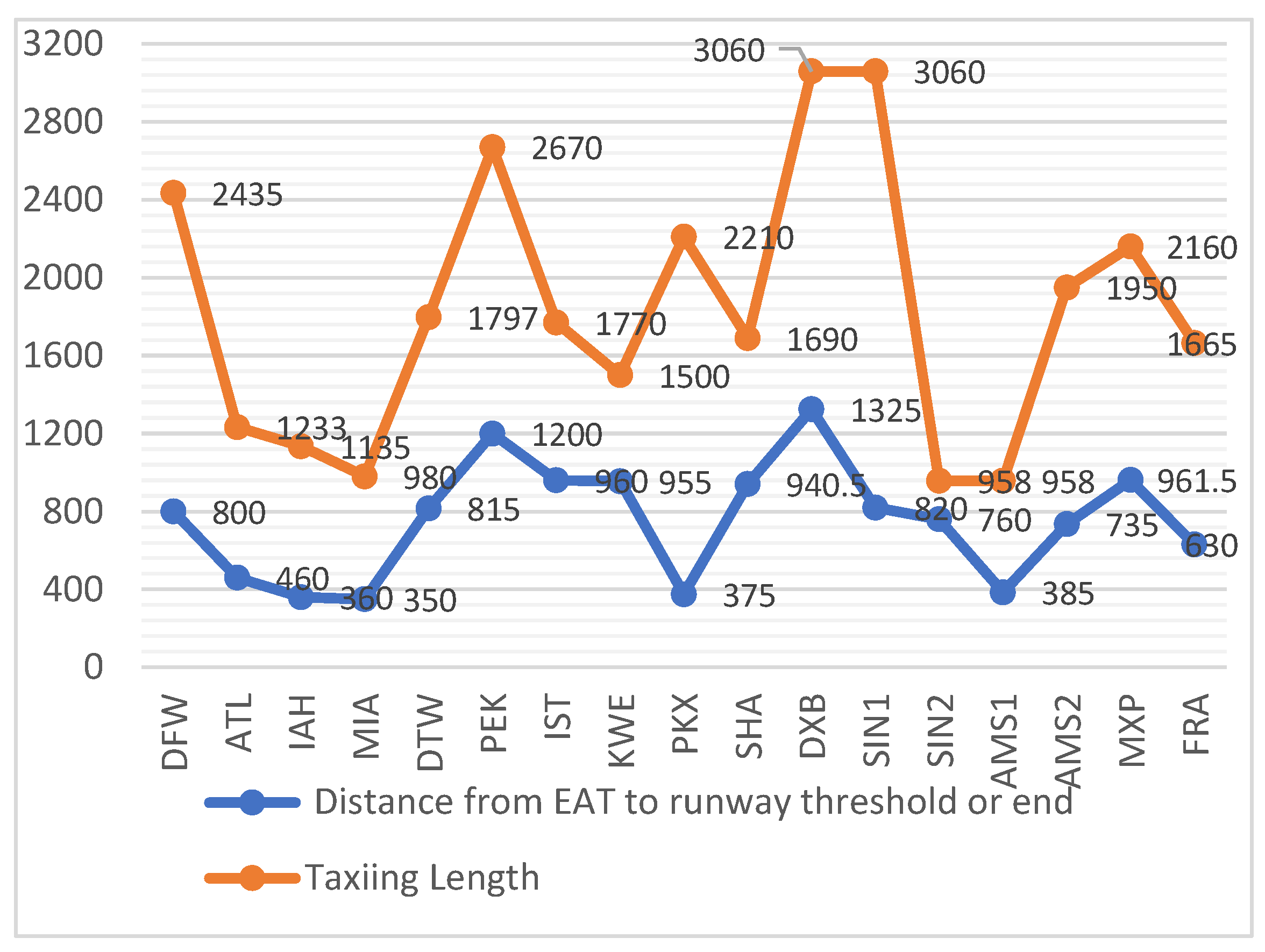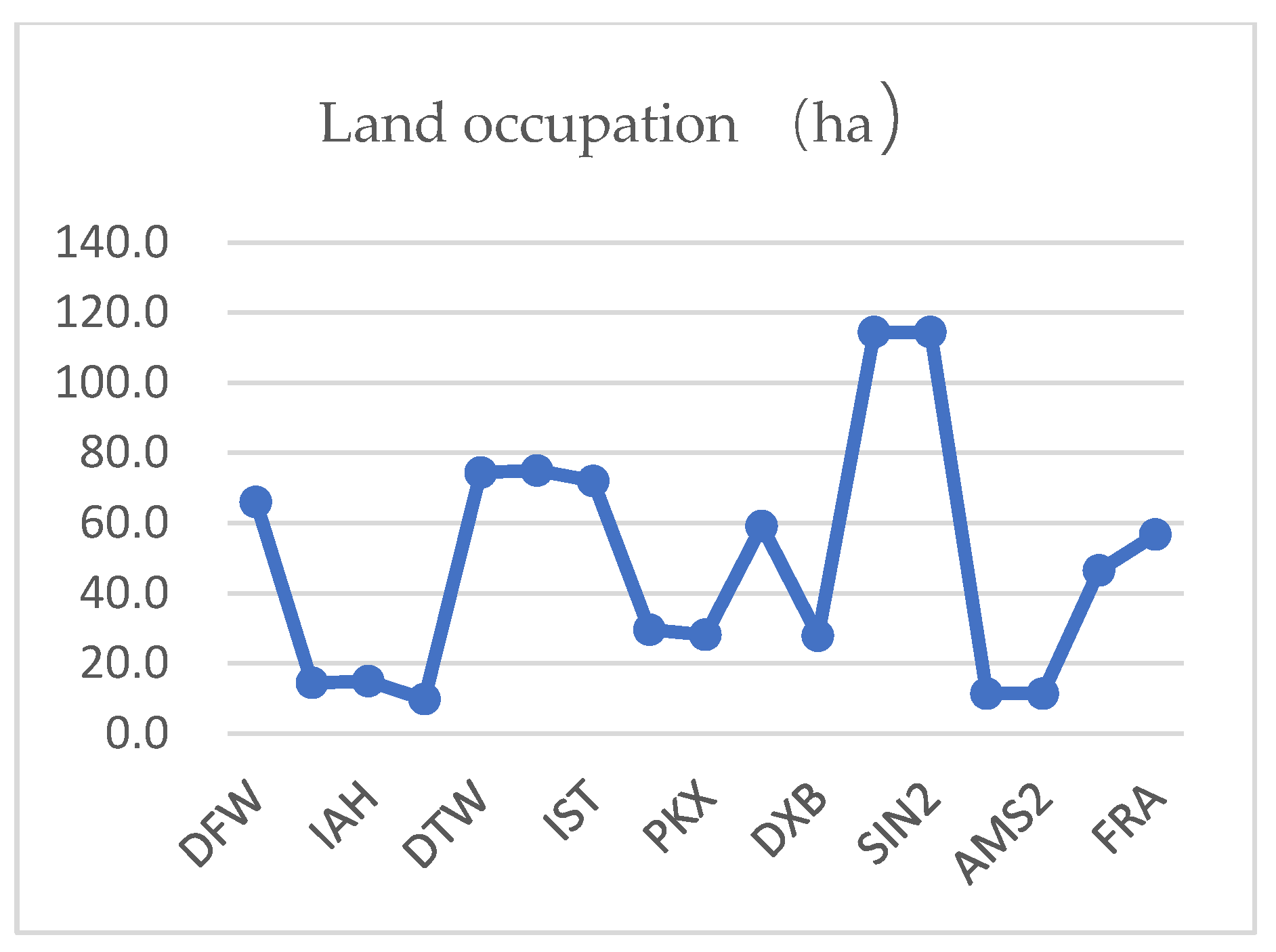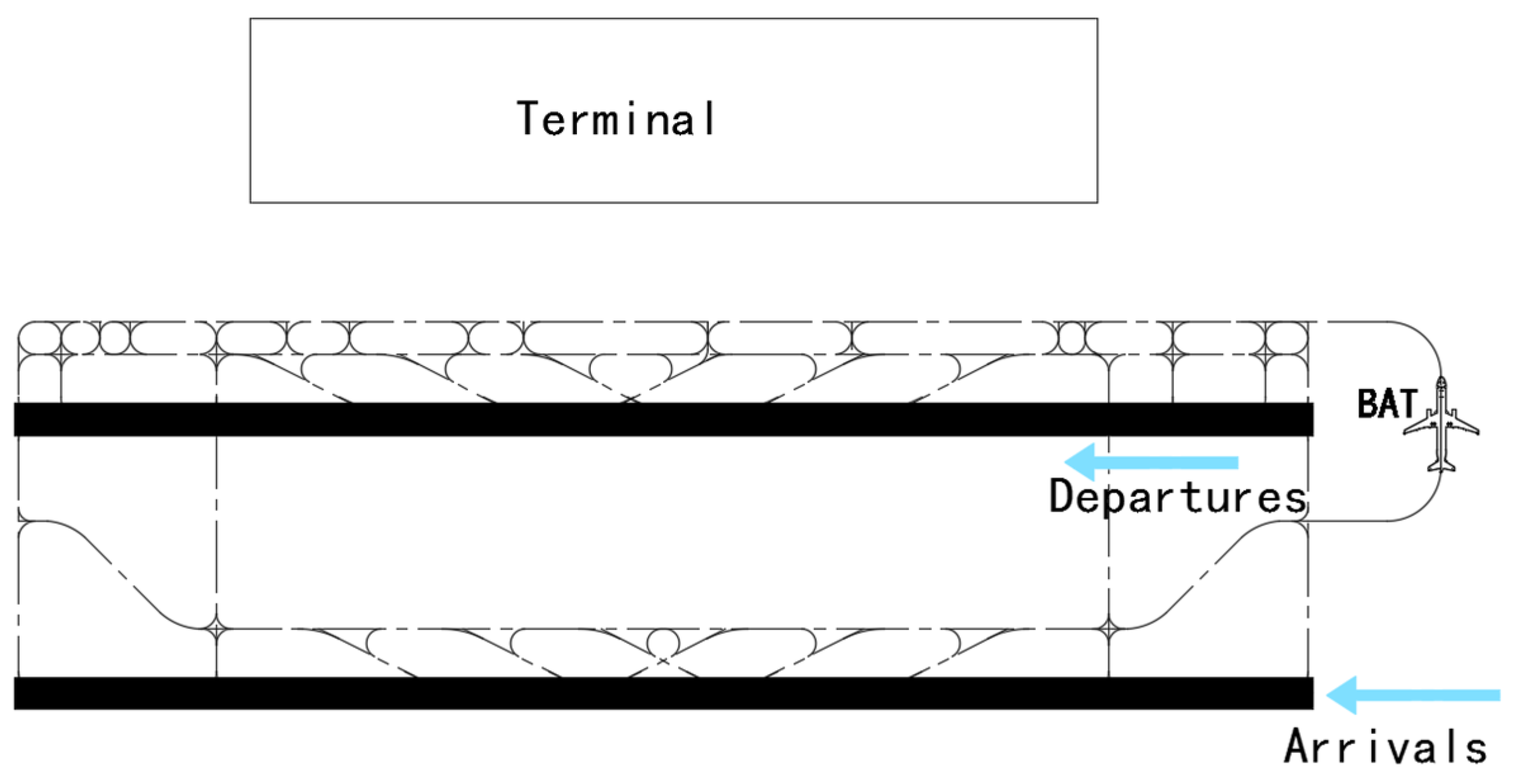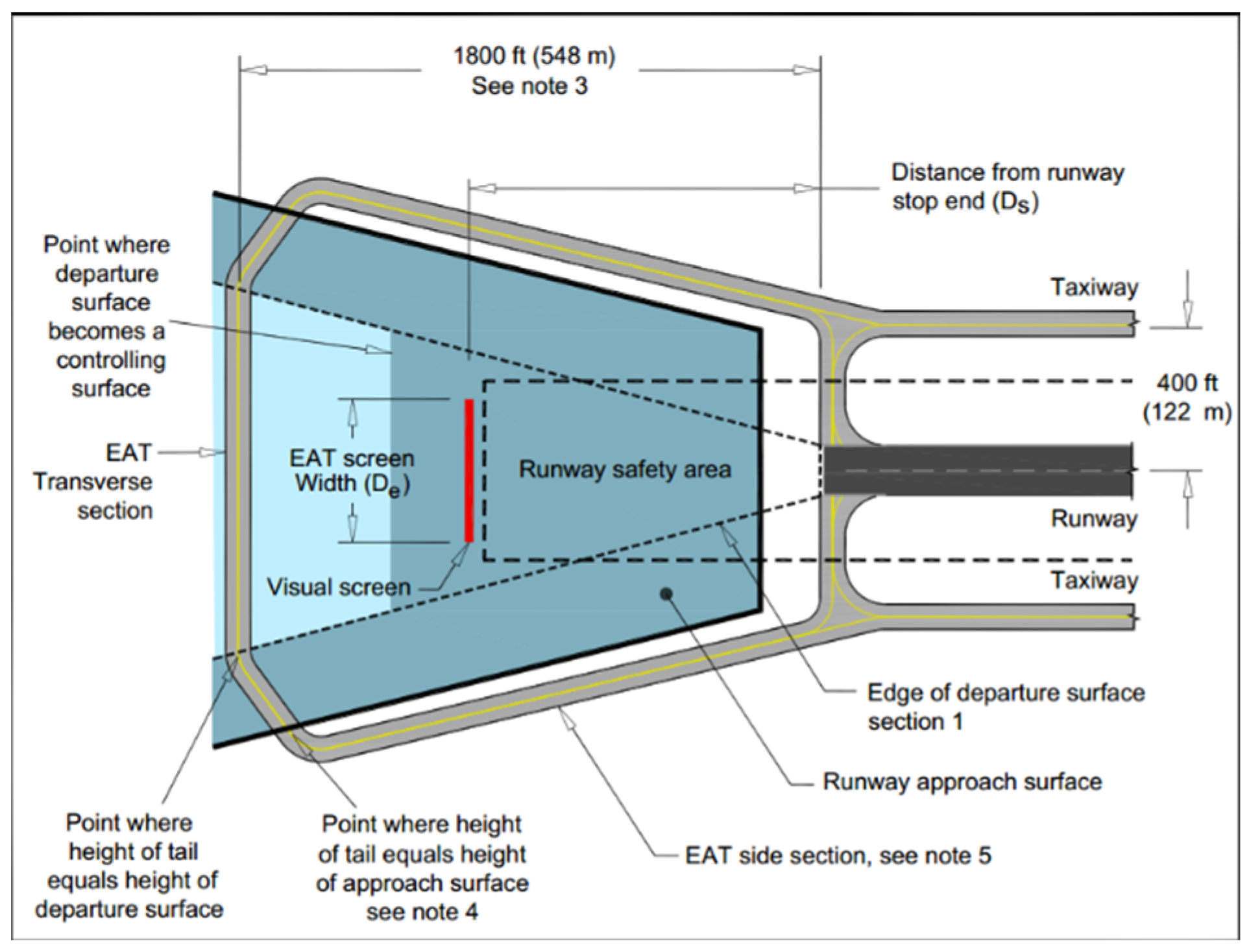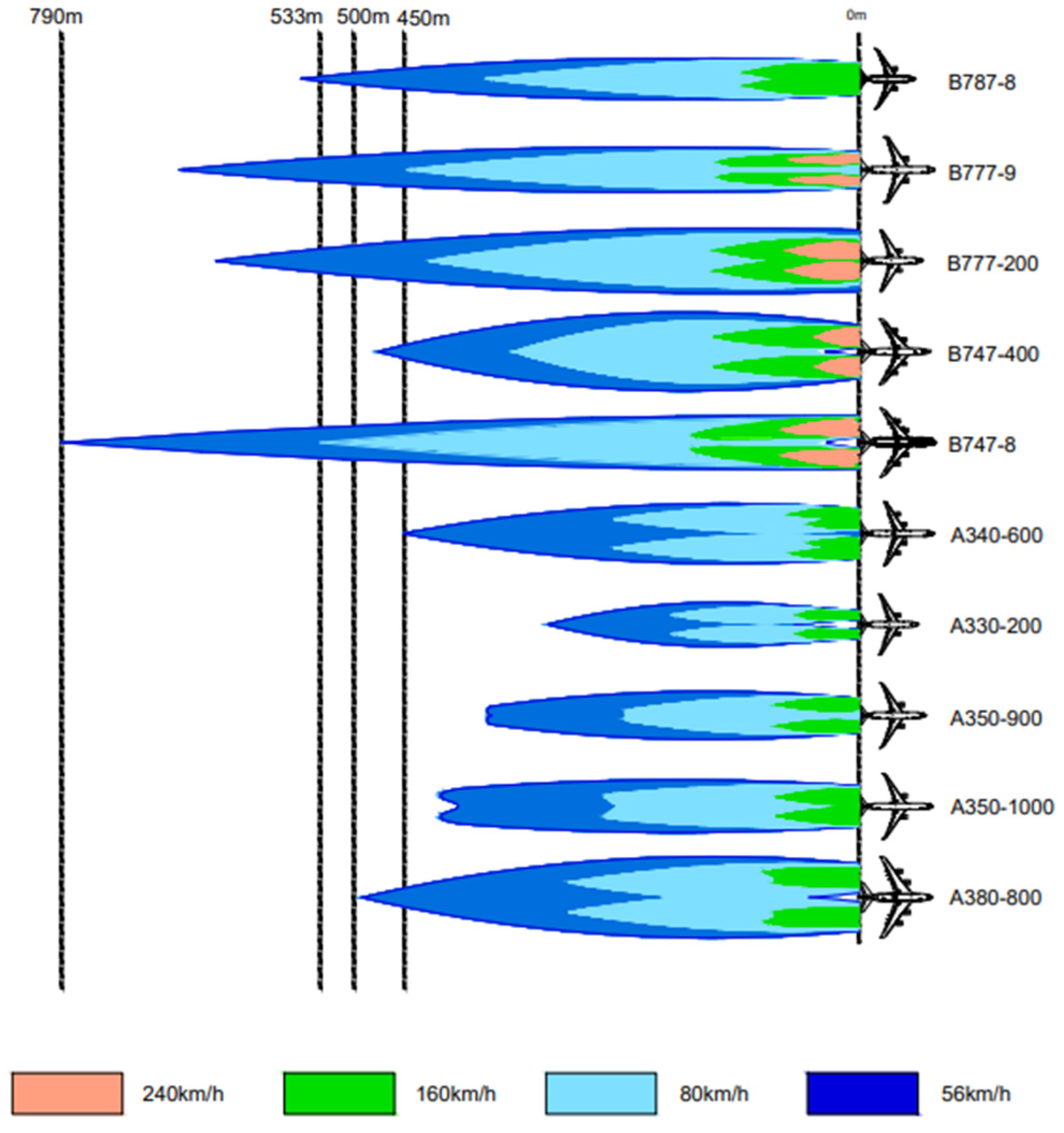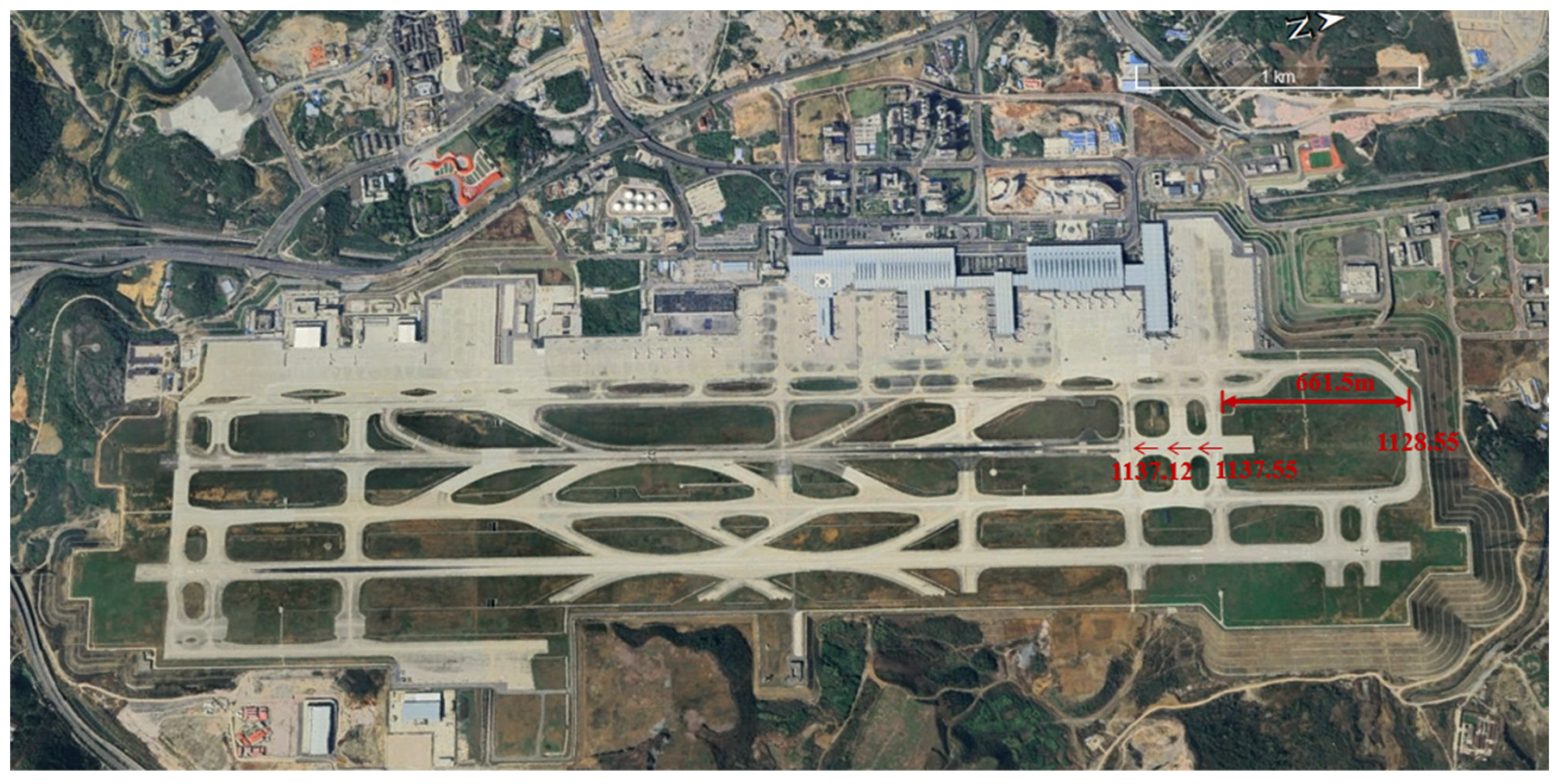4.1. ICAO and FAA Recommendations for EAT Planning
ICAO has published Standards and Recommended Practices (SARPs) for civil aviation, which are available in 19 annexes. Annex 14 Aerodromes Volume I Aerodrome Design and Operations [
70] covers the design requirements for airports, but it does not provide specific guidance on the design of taxiway fillets. The annex only provides a basic definition of taxiway fillets and offers simple design guidance, but it does not cover specific details, so its guidance is limited:
- (a)
Sufficient space is required between the landing threshold and the taxiway centerline where it crosses under the approach path to enable the critical taxiing aircraft to pass under the approach without penetrating any approach surface.
- (b)
The jet blast impact of aircraft taking off should be considered in consultation with aircraft manufacturers; the extent of take-off thrust should be evaluated when determining the location of a perimeter taxiway.
- (c)
The requirement for a runway end safety area, as well as possible interference with landing systems and other navigation aids, should also be taken into account. For example, in the case of an ILS, the perimeter taxiway should be located behind the localizer antenna, not between the localizer antenna and the runway, due to the potential for severe ILS disturbance, noting that this is harder to achieve as the distance between the localizer and the runway increases.
- (d)
Human factors and issues should also be taken into account. Appropriate measures should be put in place to assist pilots in distinguishing between aircraft that are crossing the runway and those that are safely on a perimeter taxiway.
FAA AC No 150/5300-13B is a section in the airport design chapter that describes the design requirements for the EAT and the visual obstruction screens used to help pilots distinguish between aircraft on the EAT and those crossing the runway. This is related to earlier studies in the United States on EATs at airports such as ATL, DFW, and DTW.
The Federal Aviation Administration (FAA) in the United States has recommended the following guidelines for the design of end-around taxiway layouts [
67]:
- (1)
Locate the EAT centerline a minimum of 1500 feet (457 m) from the departure end of the runway.
- (2)
The minimum length of that portion of the EAT crossing the extended runway centerline at the minimum distance of 1500 feet (457 m) is equal to the width of the departure surface of the Departure End of Runway (DER).
- (3)
Increase the minimum distances as necessary to prevent aircraft tails from penetrating the 40:1 departure surface and any surface identified in FAA Order 8260.3.
- a.
Initiate an airspace study for each site to verify that the tail height of the critical design group aircraft operating on the EAT does not penetrate these surfaces.
- b.
The airspace study will also confirm compliance with Part 121, §121.189, Airplanes: Turbine Engine Powered: Takeoff Limitations, which requires the net takeoff flight path to clear all obstacles either by a height of at least 35 feet (10.5 m) vertically or by at least 200 feet (61 m) horizontally within the airport boundaries.
- c.
In addition to the critical aircraft tail height, the elevation of the stop ends of the runway relative to the elevation of points along the EAT is a factor in determining conformance with clearance criteria.
- (4)
Locate the EAT outside of ILS critical areas.
A typical EAT is shown in
Figure 11 [
67]. The distance between the centerline of the taxiway and the Departure End of Runway (DER) is the determining factor in its design. This is influenced by many factors, including the aircraft type for the taxiway and runway, approach surfaces, takeoff climb surfaces, missed approach surfaces, use strategy for the taxiway, and communication and navigation facilities [
71]. If there is a certain height difference between the runway end and the taxiway, the terrain conditions can be fully utilized to shorten the distance between the runway end and the centerline of the taxiway.
Note 1: This example illustrates the approach surface, which controls the location of the side taxiway segments of the EAT, while the departure surface controls the location of the transverse taxiway section of the EAT.
Note 2: This example assumes all centerline elevations to be the same elevation as the runway end centerline.
Note 3: This distance varies depending upon the ground elevation of the transverse EAT transverse section relative to the applicable runway surface elevation (Departure End of Runway or threshold elevation).
Note 4: The point where the tail height equals the approach surface height is 1730 ft from the runway threshold, assuming no change in terrain elevation.
Note 5: The distance between the taxiway centerline and the outer edge of the approach surface edge is a minimum of one-half of the taxiway safety area (e.g., 59 ft).
The FAA’s AC150 advisory circular delineates comprehensive specifications for EAT layouts, specifying the minimum distance of taxiways from runway ends and setting certain dimensions for taxiways based on the tail height of different aircraft models (
Table 4). In addition, the regulations have studied methods for determining the position and height of visual obstructions and proposed the use of on-site survey methods to measure the height and width of such obstructions.
Most of the EATs in the United States are designed based on a takeoff climb surface of 1:40, without considering the one-engine-inoperative surface in management regulations [
16,
17,
36,
68]. However, most ICAO member states in Asia use takeoff climb surfaces of 1:50 or 1:62.5 to ensure unrestricted passage of aircraft taking off in front of the taxiway [
72,
73].
4.2. Principles and Steps of Taxiway Design Optimization
It is recommended to carry out the planning and design work of taxiways according to the following steps and principles.
- (1)
Land supply situation
The construction of EATs requires additional land use, and new airports need to reserve space for the construction of these taxiways in master plans. However, expansion efforts lacking original allowances for EATs have constrained land resources [
69]. Therefore, only BAT (Back-Around Taxiway) can be planned within the limited space. In some cases, aircraft may even adopt short-runway takeoff procedures, using short connecting taxiways as BATs. This practice has been implemented for many years at several airports in the United States. In the master plan of Asian airports, EATs have been included, and land has been reserved in recent years. This undoubtedly promotes the implementation of EATs in the future.
- (2)
Developing multiple EAT design options based on different aircraft types and operational characteristics.
The choice of aircraft types (tail height) is the primary determinant in the selection of EAT layout. In the designing of hub airports, accurate predictions of air traffic volume and the proportion of aircraft types are crucial factors for taxiway planning. Taking DFW as an example, when designing the EAT, D-class aircraft, such as B767 and B757, were selected as the main design types to meet the operational requirements of mainstream aircraft. However, with the gradual retirement of D-class aircraft worldwide, short-haul flights are predominantly served by C-class aircraft like B737, A320, and C919, accounting for more than 80% of operations at domestic hub airports. Long-haul flights are mainly operated by popular E-class wide-body aircraft, such as B747 and A330, while F-class aircraft have a minimal presence and are not suitable for consideration [
73,
74].
In 2023, the wide-body aircraft proportion at PEK and SHA is estimated to be around 30%. These airports serve as major international hubs and handle a significant number of intercontinental or long-haul flights. Most domestic hub airports have a widebody aircraft proportion of less than 20%. According to the Airbus Global Market Forecast 2023–2042, the demand for widebody aircraft is projected to be 8220, accounting for 20% of the market, while single-aisle aircraft are forecasted to make up 80% with 32,630 units. Except for a few international hubs, the widebody aircraft proportion at most airports ranges from 10% to 20% [
74].
Airport managers often prefer an EAT that can accommodate all types of aircraft. However, the tail height of widebody aircraft can cause excessive taxiing distances, resulting in increased taxiing time and fuel consumption. Therefore, it is recommended to carefully select the appropriate aircraft type based on the forecast. Additionally, it is advisable to compare different EAT layouts for various aircraft types (such as C or E), considering factors such as the total length of taxi routes, taxiing time, and overall fuel consumption throughout the entire life cycle of the design.
The relative positioning of taxiways, runways, and terminals, as well as the layout of EATs (such as N-shaped or M-shaped configurations), should be determined based on the overall airport master plan.
- (3)
Comparative analysis of multiple solutions in terms of technical and economic aspects over the entire life cycle.
The construction of EAT requires a significant amount of land and incurs substantial engineering costs. The height difference between the runway and the EAT can reduce the taxiing distance but results in a large volume of earthwork. Therefore, it is necessary to compare different EAT layouts with varying elevations and different aircraft types and flows based on indicators such as taxiing time, fuel consumption, and engineering costs over the entire life cycle.
4.3. Limiting Requirements in End-Around Taxiway Design
In this section, we outline the fundamental considerations for EAT planning and design, drawing on real-world construction expertise and EAT categorization. Recognizing the intricate nature of EAT design with its array of requirements, this article puts forth a succinct synthesis of salient points, intending to provide planners and designers worldwide with an indispensable reference.
The N-type, M-type, and large N-type classification of EATs relates to runway and terminal layout, which is beyond this paper’s scope. Therefore, this article focuses on summarizing the key design considerations for SAT, REAT, and BAT classifications.
Table 5 demonstrates the Limiting Requirements of BAT, REAT, and SAT end-around taxiways. Flight procedures encompass the horizontal paths and vertical profiles of all stages of aircraft approach and departure. It is a crucial factor to consider in the design of EATs. Flight procedure design takes into account airport topography, airspace, navigation facilities, and relevant regulations. Presently, there are two main internationally recognized flight procedure design specifications: ICAO DOC8168 [
75] and the FAA Order 8260.3 F (TERPS) or Order 8260.58 C. As mentioned earlier, the FAA has already provided a comprehensive summary of EAT limiting factors under TERPS. This study is based on the research conducted using the 6th Edition of DOC8168 [
75], focusing specifically on the EAT design for SAT, REAT, and BAT modes within Category I, II, and III precision approaches in flight zones with aerodrome reference code number 3 or 4 [
70].
Please note that the planning of EAT is complex. This article only focuses on the impact of taxiways on the runway that aircraft may go around. However, it is important to note that if the distance between parallel runways is close (approximately 300 m), the EAT can also affect both runways. Due to the limited scope of this article, this aspect will not be discussed in further detail, but it is crucial for planners to take this factor into account.
4.3.1. BAT (Back-Around Taxiway)
The aircraft operating on the EAT taxis behind the departing aircraft, so there are no obstacle limitation surfaces involved in takeoff or landing. The BAT primarily considers the impact of jet blasts from departing aircraft. However, the taxiway itself (excluding the operating aircraft) should not penetrate the ILS surface of the airport.
Figure 12 illustrates the impact range of a jet blast during takeoff for a typical aircraft. It is generally considered that a jet blast wind speed of 56 km/h is tolerable for people, vehicles, or other movable devices [
76,
77,
78,
79]. The B747-8 has the longest 56 km/h jet blast range [
67], starting at approximately 533 m. Only a few aircraft, like the B747-8 and B777-200, require distances greater than 450 m.
However, it should be taken into consideration that after the aircraft enters the runway, the takeoff starting point is typically situated about 70–80 m away from the runway threshold [
73,
80,
81]. The aircraft requires a certain distance to prepare for takeoff and reach full power. Therefore, a length of 350–385 m is considered sufficient to meet the blast limit. For instance, PKX has a BAT of 375 m from the runway threshold, which satisfies this requirement.
For the BAT mode, if the runway is equipped with an ILS (Instrument Landing System), the distance of 350–385 m is generally considered outside the critical zone but cannot completely prevent entry into certain sensitive areas. But, when an aircraft is operating on the BAT, the runway is in a takeoff state and the LOC (Localizer) and GP (Glide slope) signals are not active.
The BAT is typically positioned within the protected area of the approach lighting system. It is recommended to refrain from installing lights on the surface of the BAT. However, lights on the shoulder of the BAT are allowed. These shoulder lights should be embedded to prevent protrusions and potential obstruction on the taxiway. It should be noted that the elevation of these lights aligns with the terrain, which may not comply with the required slope ratio of 1:66 for ascent or 1:40 for descent. Consequently, meticulous coordination between terrain design and the elevation of the light fixtures is imperative to ensure compliance with the applicable specifications.
4.3.2. REAT, Runway End-Around Taxiway Mode
The aircraft operating on the Runway End-Around Taxiway taxis in front of the departing aircraft. Therefore, careful consideration of the influence of aircraft operating on the REAT on the departing aircraft is essential.
The Precision Approach Path Obstacle Limitation Surfaces and the Basic Instrument Landing System (ILS) surfaces specified in Annex 14—Aerodromes of the International Civil Aviation Organization (ICAO) [
70] are consistent. They primarily include the Conical Surface, Inner Horizontal Surface, Approach Surface, Inner Approach Surface, Transitional Surface, Inner Transitional Surface, Balked Landing Surface, and Takeoff Climb Surface. EATs should be located outside the Basic ILS surfaces [
67].
REAT is primarily used in front of the departing aircraft. The take-off climb surface serves as the primary limitation surface for restricting factors. In the direction of the runway extension centerline, the dominant limiting factors include a limitation surface that begins 60 m from the runway end with a gradient of 2%. The vertical restrictions consist of a lateral separation rate of 12.5% and a starting width range of 180 m [
72,
73].
Furthermore, the operation of REAT must not interfere with the operation of an adjacent runway. The approach for addressing this issue is similar to the SAT mode and will not be discussed in detail in this article.
- 2.
Flight Procedures and Aircraft Performance Restriction
In the International Civil Aviation Organization (ICAO) DOC 8168 [
75] regulations, the primary factors that affect EAT are the procedures near the vicinity of the runway end, including approach procedures, departure procedures, the basic ILS surface, and the Obstacle Assessment Surface (OAS). Additionally, considerations are given to the Visual Segment Surface (VSS) and the Aerodrome Obstruction Chart-ICAO Type A (Operating Limitation) [
82,
83].
The operation of REAT does not require consideration of approach-related procedures. It only needs to consider the restrictions of Obstacle Identification Surface (OIS) and the Aerodrome Obstruction Chart-ICAO Type A (Operating Limitation) in the departure procedure.
(1) Obstacle Identification Surface (OIS): The purpose of the OIS is to determine whether there is a potential collision risk between obstacles within the protected area and departing aircraft. The OIS begins at the Departure End of Runway (DER), starting at a height of 5 m and gradually sloping upward at a gradient of 2.5%. It has an initial width of 300 m and expands towards both sides of the runway at a rate of 15%. Obstacles must maintain a lower height than the OIS [
84,
85].
If obstacles within the protected area do not penetrate the OIS, it does not affect instrument departure aircraft. The aircraft can climb following the published procedure gradient of 3.3% (2.5% + 0.8%) [
82]. However, when obstacles penetrate the OIS plane, a flight path must be specified in the departure procedure or the departure climb gradient must be modified to ensure enough vertical clearance for the aircraft to safely fly over the obstacles. If this condition cannot be met, the aircraft should reduce its load. Obstacles below 60 m can be visually avoided.
The REAT design should strive to ensure that aircraft operating on it remain below the OIS. However, certain modified airports may encounter challenges in meeting this criterion due to terrain limitations. In such situations, the requirements for taxiway operations can be fulfilled by making adjustments to the Procedure Design Gradient (PDG), reducing the payload of specific aircraft models, or employing visual obstacle avoidance techniques.
(2) Aerodrome Obstruction Chart-ICAO Type A (Operating Limitation): The purpose of the Type A surface is to guarantee that aircraft can successfully clear obstacles within the designated takeoff path in the event of an engine failure. If this requirement cannot be met, the takeoff weight should be reduced by decreasing the effective payload. The Type A surface originates from the published endpoint of the takeoff area and has a climb gradient of 1.2% [
82]. It initially has a width of 180 m and gradually expands at a rate of 25% on both sides until reaching a fixed width of 1800 m [
86].
In practice, the design of taxiways does not take into account the constraints of the Type A surface. This is mainly due to its stringent requirements, which result in longer distances between the EATs and the runway. Aircraft operating on taxiways act as moving obstacles and can provide emergency avoidance in the case of an engine failure, which is a significant difference compared to fixed obstacles.
As shown in
Figure 13, the limitations set by Appendix 14 surfaces, the Obstacle Identification Surface (OIS), and the Type A surface were computed incrementally along the runway extension line and in the vertical runway direction. The calculations were based on the assumption that the runway elevation is equal to the taxiway elevation. It is clear that the requirements of the Type A surface are excessively strict. As a result, the practical scenarios do not take the Type A surface requirements into consideration.
Step 1: Calculate the length requirements in the direction of the runway centerline extension.
As shown in
Table 6, the primary constraint for the REAT along the extended centerline of the runway is the takeoff climb surface, which is aligned with the approach and inner approach surfaces. This constraint starts 60 m beyond the runway end and mandates a climb gradient of 2%.
Step 2: Determine the position of the REAT along the extended centerline direction of the runway, taking into account the 2% climb gradient constraint determined in the previous step. Based on this position, calculate the restricted widths of the takeoff climb surface, OIS, and Type A surface in the vertical direction of the runway. Make a comparison between these widths.
The width layout of REAT should consider the impact of the OIS to ensure that the aircraft’s tail remains below the OIS. If necessary, measures such as load reduction or avoidance should be taken in case of penetration. However, it is important to note that the limitations of the takeoff climb surface should never be exceeded.
Table 7 shows the comparison results.
- 3.
Other Requirements
The REAT is calculated based on the takeoff climb surface and is positioned beyond 660 m from the runway end. If the runway is equipped with an ILS guidance system, this position is already located outside the critical and sensitive areas of the Localizer (LOC) and Glide Path (GP). However, if adjustments are made, such as lowering the REAT height, there is a possibility that the REAT system might enter into these sensitive areas. Nevertheless, during REAT operation, when aircraft are taking off, the LOC and GP signals are not active. Therefore, similar to the BAT model, it is sufficient to assess the potential impact of this situation.
If the REAT is located beyond 960 m, there is no need to extensively consider its impact on the approach lighting system. However, if the REAT is located within the protected area, similar to the BAT system, the lights should be installed on the shoulder instead of the pavement. The elevation of these lights may align with the terrain, which may not meet the required slope ratio of 1:66 for ascent or 1:40 for descent. Therefore, meticulous coordination between terrain design and light elevation is necessary to ensure compliance with the relevant specifications.
The REAT mode also needs to consider visual screens. Metal visual screens and terrain shielding are commonly used in practice. The impact of metal visual screens on the ILS signal should be taken into account. Regardless of the chosen method, the height of the visual screen must satisfy both the requirement to shield the aircraft engines when taxiing on the REAT and to ensure unobstructed observation of approach lights by the pilot. These interdependent requirements make the elevation of this area complex and often a critical factor in determining the feasibility of REAT planning.
4.3.3. SAT, Start-Around Taxiway Mode, Unrestricted EAT
SAT (Start-Around Taxiway) is constructed before the runway entrance, enabling aircraft on SAT to taxi undisturbed without disrupting approaching aircraft. The SAT integrates the capabilities of both EAT and BAT, functioning as an unrestricted end-around taxiway with full functionality.
The SAT as an unrestricted EAT requires consideration of numerous constraint surfaces; constraint surfaces previously analyzed for REAT will not be revisited here. Only constraints imposed by SAT end-around taxiing aircraft on approaching aircraft are examined: the conical clearance surface, inner horizontal surface, approach surface, inner approach surface, transitional surface, inner transitional surface, and balked landing surface.
It should be noted that for REAT, taxiing occurs prior to aircraft takeoff; thus, the datum point is the runway end. For SAT, taxiing is under the arriving aircraft, so the datum point is the runway threshold [
87].
For most runways, the takeoff end and opposite direction threshold coincide. However, due to the demanding obstacle limitation surface requirements for end-around taxiways, many airports displace the threshold or runway end depending on the taxiway type (SAT or REAT).
Inner transitional surface: due to their steep gradients and location primarily lateral to the runway, the inner transitional and transitional surfaces do not constrain end-around taxiways.
Approach surface: for aerodromes with runway codes 3 or 4, the approach surface starts 60 m from the threshold, with an initial width of 280 m, divergence of 15%, and first segment length of 3000 m (the end-around taxiway range) at a 2% slope [
70].
The inner approach surface begins at the same starting point as the approach surface, with a width of 120 m, length of 900 m, and gradient of 2%. The spatial extent of the inner approach surface is less than that of the full approach surface [
70].
Balked landing surface: For code 3 and 4 runways, the balked landing surface commences 1800 m from the threshold at a 3.33% gradient. Its precipitous slope obviates constraints on end-around taxiways [
70].
Along the extended runway centerline, the primary limitations include the 2% climb gradient surface (approach and inner approach surfaces) originating 60 m beyond the runway threshold. Vertically, the restrictions are a 15% divergence and 280 m initial width for the approach surface [
70].
- 2.
Flight Procedures and Aircraft Performance Restriction
The SAT involves the complete arrival and departure procedures. The departure constraints, such as the OIS and Type A surfaces, are identical to the EAT mode and will not be reiterated. The arrival constraints of VSS, OAS, and CRM procedures will be discussed.
- (1)
The Visual Segment Surface (VSS)
The Visual Segment Surface originates 60 m from the runway threshold, with an initial width of 300 m, 15% divergence on both sides, and a length extending to the point where the VSS surface reaches the Obstacle Clearance Height (OCH) altitude. Vertically, the initial elevation of the VSS equals the runway elevation, with an upward slope equal to the glide path angle minus 1.12 degrees, generally 3 degrees.
Figure 14 demonstrates the vertical direction of the VSS.
- (2)
The Obstacle Assessment Surface (OAS)/Collision Risk Model (CRM)
The Obstacle Assessment Surface (OAS) proposed in ICAO Doc 8168 “Procedures for Air Navigation Services—Aircraft Operations” states that if the OAS is penetrated, the OCA/H must be raised, thus increasing the Aerodrome operating minima. The Collision Risk Model ensures that the collision risk between aircraft on precision approach and surrounding obstacles is below 1 × 10
−7 [
75].
Since the OAS is above the basic ILS, the ILS is evaluated first. If obstacles penetrate ILS, OAS is applied. OAS comprises simplified surfaces derived from CRM’s calculated 1 × 10
−7 collision probability. CRM serves as an alternative when obstacle density below OAS is excessive [
88].
Therefore, for EATs meeting basic ILS requirements, the OAS/CRM serves only as a checkpoint surface. In cases where the end-around taxiing aircraft penetrates the ILS surface, the OAS surface needs re-evaluation, and methods like adjusting flight procedures should be applied to eliminate obstacle impact without compromising flight safety.
In summary, the Annex 14 limiting surfaces and the VSS are calculated separately in the extended runway centerline direction and perpendicular to the runway [
70]. The calculations are based on the assumption that the runway elevation is equal to the taxiway elevation.
Step 1: Calculate the length requirements in the direction of the runway centerline extension, as shown in
Table 8.
Along the extended runway centerline, the primary limitations of the SAT include the 2% climb gradient surface (approach and inner approach surfaces) originating 60 m beyond the runway threshold.
Step 2: Based on step 1, calculate the restricted widths of the approach surface, VSS, in the vertical direction of the runway.
Table 9 makes a comparison between these widths.
Vertically to the runway, besides the approach surface, the relationship between end-around taxiing aircraft and the VSS surface must be considered. If unavoidable VSS penetration occurs, methods like adjusting flight procedures should be implemented.
- 3.
Other Requirements
Unlike REAT, SAT operations need to account for the approach lighting system. Neither the end-around taxiway nor the aircraft should obstruct the approach lights. The taxiway has to be placed beyond the 960 m protection area from the threshold. However, this leads to excessive taxiing distance and land use. Generally, displacing the threshold inward shifts the approach lights and reduces the taxiing distance. The threshold is displaced no more than 300 m to minimize impact on pilot landing operations.
Airports like SHA and KWE have implemented threshold displacement. For KWE, the displaced threshold enables the unrestricted SAT to avoid impacting the approach lighting system. Thresholds at airports like SHA and DFW have more considerations, such as visual obstructions, which are detailed in
Section 4.
SAT is termed an unrestricted EAT because it fulfills the REAT, BAT, and SAT modes, operating as a truly unconstrained bypass. Air traffic controllers can select the most proximate, optimal, and appropriate route per real-time runway flow to swiftly guide aircraft to the apron, potentially with no instructions required.
The unrestricted EAT has limited international implementations. Following project completion and commissioning in 2022, KWE’s application has received strong support from air traffic control. More airports are starting to evaluate the unrestricted end-around taxiway model.
4.4. Visual Impediment
Visual impediments are inherent to REAT operations. As the taxiing aircraft crosses in front of the departing aircraft, visual separators between the runway end and REAT are required to obscure aircraft on the REAT from the pilots’ view. This prevents confusion with any incursion aircraft at the runway end, allowing pilots to clearly distinguish between normal bypass taxiing and potential runway incursions.
FAA pioneered research into visual screens, constructing the first one with metallic materials. In 2007, through a field trial at the ATL end-around taxiway case [
89], the FAA evaluated visual screen materials, structures, patterns, colors, and lighting methods via pilot questionnaires. Guidance on siting and implementing visual screens was finally provided in AC150 [
67] and its attachments, based on this evaluation;
Figure 15 demonstrates end-around taxiway screen sizing and location [
67],
Figure 15 shows the End-around taxiway screen sizing and location guidance in AC150.
The world’s first visual screen was born at DFW. In 2021, DFW also installed visual screens in front of the north REAT.
(1) Horizontal Geometry: Base the design of the screen width on a departing aircraft’s view from a location at the V1 point through the farthest point on the runway hold line at the departure end of the runway.
where:
= 0.4
= Distance from the departure end of the runway to the screen
= Distance from the runway centerline to the hold line
= Width of the EAT Visual screen
(2) Vertical Geometry: Design the height of the screen so that the top of the screen masks that portion of an aircraft that extends up to the top of an engine nacelle of the ADG taxiing on the EAT, as viewed from the cockpit of the same ADG at the V
1 point on the departure runway.
where:
ELEVV1 = MSL elevation of the runway centerline at the V1 point, 60%of the length of the runway from the takeoff threshold
HEYE = Height of the pilot’s eye above the runway
HNACELLE = Height of the engine nacelle above the taxiway
ELEVEAT = MSL elevation of the centerline of the EAT
DEAT = Distance from the departure end of the runway to the screen
LRWY = Length of the runway
ELEVGAS = MSL elevation of the ground at screen
AC150/5300-13B also provides basic specifications for the material and composition of visual screens.
However, siting metallic visual screens is extremely challenging for two primary reasons:
Firstly, the screens are situated between the runway end and REAT; thus, the metal’s unique properties may impact critical and sensitive areas for ILS and approach lighting systems [
43,
90,
91]. These areas should be avoided, if possible, but even after successful avoidance, subsequent relevant testing cannot be precluded, as large metallic surfaces can potentially induce signal effects that are difficult to predict.
Secondly, while visually blocking pilots’ sightlines, the screens must not obstruct signals for approach lights and navigation antennas. Concurrently, the screens cannot penetrate any obstacle limitation surfaces either. Therefore, after location selection, meticulous calculations are required to determine permissible width and height.
Although the FAA provided some recommendations, the actual implementation of metallic visual screens is complex and sometimes nearly infeasible to replicate. Nonetheless, the FAA’s fundamental research on aspects like materials and colors remains constructive.
With the development of communication and information technologies, the density of cables, fiber optics, and other infrastructure inside aerodrome maneuvering areas has increased. Some new communication and navigation facilities, such as GBAS (Ground Based Augmentation System) antenna arrays, are also increasing. Metallic visual screens may have unknown effects on the aforementioned equipment. For example, metallic screens can create false targets for surface surveillance radars. At the same time, the limitations of sensitive or critical areas for multiple devices also pose challenges for siting metallic visual screens [
90,
92]. As a result, the global use of metallic visual screens is not widespread. So far, only DFW, DTW, and SHA have utilized metallic visual screens.
Table 10 compares the basic information of visual screens in three airports.
Metallic visual screens have been installed on both the north and south end-around taxiways at SHA and were put into use in 2022. The southern screen is located on the ground surface south of the runway, while part of the northern screen is erected above the regulatory pond.
Before the metallic visual screens were put into operation at SHA, relevant authorities conducted simulations and field tests to analyze their impact on ILS signals and surface movement radar signals. The panels were finally installed and tilted 12° (±1°) to minimize or eliminate false radar targets caused by surface reflections [
34].
Analyses were also conducted on the impact of visual screens at different locations on the ILS system. According to the simulation result, the visual screen mainly affects the glide path antenna signal, and the distance between the screen and glide path antenna should be greater than 800 m [
92]. Before installation, the possible influence of a screen on the signal of the glide path should be analyzed.

